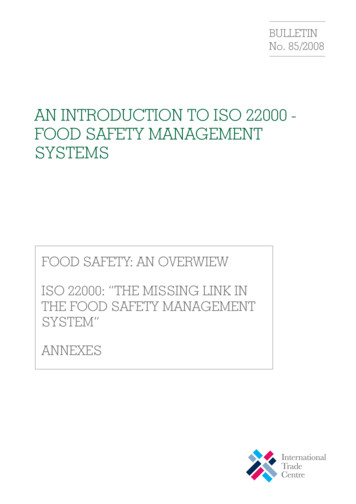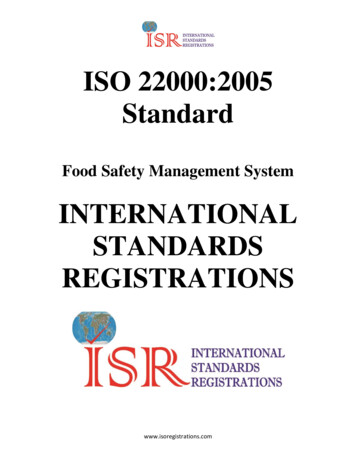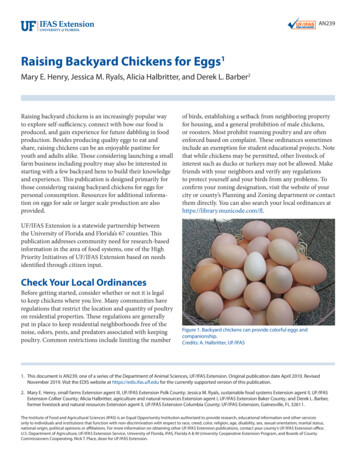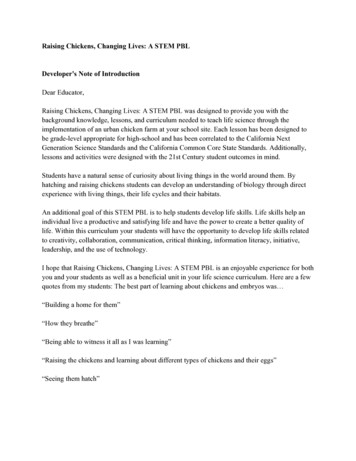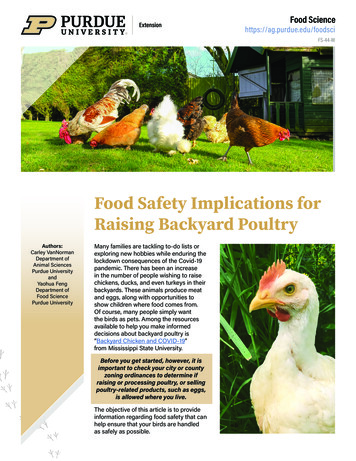
Transcription
Food Sciencehttps://ag.purdue.edu/foodsciFS-44-WFood Safety Implications forRaising Backyard PoultryAuthors:Carley VanNormanDepartment ofAnimal SciencesPurdue UniversityandYaohua FengDepartment ofFood SciencePurdue UniversityMany families are tackling to-do lists orexploring new hobbies while enduring thelockdown consequences of the Covid-19pandemic. There has been an increasein the number of people wishing to raisechickens, ducks, and even turkeys in theirbackyards. These animals produce meatand eggs, along with opportunities toshow children where food comes from.Of course, many people simply wantthe birds as pets. Among the resourcesavailable to help you make informeddecisions about backyard poultry is“Backyard Chicken and COVID-19”from Mississippi State University.Before you get started, however, it isimportant to check your city or countyzoning ordinances to determine ifraising or processing poultry, or sellingpoultry-related products, such as eggs,is allowed where you live.The objective of this article is to provideinformation regarding food safety that canhelp ensure that your birds are handledas safely as possible.
FS-44-W Food Safety Implications for Raising Backyard PoultryWhy do I need to care about food safety?What preventive measures can we take when mykids or I play with the birds?Each year, thousands of Americans get sick fromconsuming food contaminated with dangerousbacteria, such as Salmonella, E. coli, andCampylobacter. These bacteria are commonin chickens and other birds raised in backyardsor in “free-range” settings. Bacteria can be transmittedto eggs and poultry meat when those productshave not been cleaned or prepared properly.Many people like to keep backyard poultry as pets, anexperience that can offer educational opportunities.Handling the birds, even the cute chicks or ducklings,and then preparing or eating food can expose peopleto dangerous bacteria. Therefore, anyone handlingpoultry must thoroughly wash their hands with soapand water for more than 20 seconds (the time it takesto sing the “Happy Birthday” song twice). Rememberto wash your hands after handling or playing withthe birds or even being in the animal’s environment.You can avoid bringing the bacteria from the coopsinto your home by changing shoes or boots aftervisiting the birds.How do bacteria travel to my food?There are many ways for food to come in contact withbacteria. As stated above, many harmful bacteria areregularly found in the intestines of animals. Thesebacteria get transmitted to meat or eggs whenthose products come in contact with the animal’sfeces or litter, either directly or through the animal’senvironment. As the animals are slaughtered andopened, there are opportunities for intestinal contentsto come in contact with the carcass. It may not stopthere because carcasses or meat that are mishandledcan lead to cross-contamination of other foods.Examples of this are cutting ready-to-eat vegetableswith the same utensils or using cutting boards thatwere used to process raw meat without washingand sanitizing them. The best way to prevent peoplefrom being exposed to these bacteria is by followingfood safety procedures when harvesting, storing,and handling eggs and meat.What are the steps to take to properly process mybackyard poultry?Many people who have chickens at home may wantto slaughter and process the birds themselves insteadof taking them to a commercial processor (always anoption). During the processing, however, there aremany opportunities for the carcass to come in contactwith bacteria. Steps can be taken to minimize thisrisk. Foremost, those doing the processing should beskilled in how this is done, from the start (slaughter)to the end (packing and storing). Oklahoma StateUniversity produced a resourceful video to showcaseprocessing of backyard poultry.2
FS-44-W Food Safety Implications for Raising Backyard PoultryFollowing exsanguination and removal of feathers,the birds are processed; the head, feet and internalorgans are removed. This should be done with utmostcare so as to not perforate the digestive tract, toprevent contents from coming in contact with thecarcass. At this point, the carcass should be washedthoroughly with clean water and chilled immediatelyat refrigeration temperature. The best way to do thisis to submerse the birds in an ice bath. Simply fill alarge container with water and copious amounts of ice,enough to completely cover the birds. The containershould also be big enough so that the birds are notcrowded. Freshly slaughtered birds are warm (internaltemperature of about 107ºF), so have plenty of iceon hand because the ice will melt rapidly. The goalof an ice bath is to bring the temperature of thechickens to 40 F within an hour. The best wayto check the bird’s temperature is by using a meatthermometer placed in the thickest part of thechicken (breast or thigh). Avoid touching the bonewith the thermometer, because that can cause aninaccurate temperature reading. The thermometershould be cleaned between uses to prevent crosscontamination. As with scalding water, chilling watershould also be changed regularly as physical matter(potentially containing harmful bacteria) accumulates.After removing processed poultry from the ice bath,place poultry in individual bags. Bags help to keeppoultry from becoming contaminated. Bags containingprocessed poultry should be dated and labeledbefore going into a freezer. If you want to freeze themeat, know that it must be consumed within therecommended time length (9 months for poultry partsand 12 months for whole poultry). If the poultry isto be refrigerated, it should stay in the fridge for onlyone or two days. Before two days is up, the meatshould either be frozen or consumed.All processing environments, tools, and utensils mustbe cleaned and sanitized before use. A big source ofcontamination is perforation of the digestive systemduring processing, exposing the intestinal contentsto the carcass. To reduce the risk of contamination,producers should withhold feed from the birds for6 to 12 hours prior to slaughter. The feed withdrawalwill allow the digestive system to be emptied. Watershould still be provided to the birds during thistime period.Birds are slaughtered by exsanguination – removalof the blood. In commercial processing facilities, thebirds are first stunned; they are given some sort oftreatment, such as an electric shock, that rendersthem insentient – incapable of feeling pain. Thestunned bird is orientated, head toward the ground,and exsanguinated by severing the jugular veinsin the neck with a sanitized and very sharp knife.This allows the blood to leave the bird.Once the bird has bled out, it is placed in scaldingwater (140ºF). The scalding process loosens feathers,which will be plucked. Scalding water should bechanged frequently; as it becomes dirty, it serves as asource of cross-contamination for subsequent birds.Wastewater from butchering should be disposed eitherin a compost pile or, if there is a small amount, in asewer system. The wastewater is high in bacteria andcan make others sick if it is not disposed of correctly.Make sure that the wastewater is not used to wateryour fruit and vegetable garden. The wastewater couldcontaminate the produce you are growing. Again, it isimportant to check city and country zoning ordinancesto determine which practices are allowed and whichpractices are not.What are the steps to take to properly collect andclean eggs?Eggs should be collected at least once a day to limitexposure to bacteria within the nesting environment.An eggshell is porous. Therefore, water used to washeggs should be warmer (at least 20ºF warmer) thanthe egg itself, to prevent debris and bacteria frombeing pulled through the shell pores. A clean, sanitizedcloth or brush can be used to scrub the outside of theshell to remove foreign material. An approved eggwash detergent or special cleaning wipes can be usedto clean the eggs. The special detergent and wipescan be bought at a store that sells farm supplies.If you buy the cleaning products online, make surethe website and vendor are credible.3
FS-44-W Food Safety Implications for Raising Backyard PoultryWhat are the recommended cooking tips to preventfoodborne illness?Eggs can be sanitized by using a homemade solutionof 1 tablespoon household bleach to 1 gallon of cleanwater. It is important to note that you should NOTsubmerge the eggs into the water. The eggs shouldbe completely dried and placed into unused, new eggcartons and placed immediately into the refrigerator.To prevent foodborne illness, don’t overlook thecooking process. The internal temperature ofegg dishes should reach 160ºF, and the internaltemperature of poultry dishes should reach 165ºF. It isalways important to use a food thermometer to ensurethe internal temperature reaching the recommendedtemperature. Appearance and texture are not alwaysreliable to ensure the food being fully cooked.What should I do to properly store the eggs and theprocessed poultry?Why all the fuss about temperatures? Becausebacteria have optimal temperatures for growth. Thistemperature range, between 40 F and 140 F, is knownas the “danger zone,” where bacteria can flourish.Even the best processed poultry products cannotbe considered sterile, or completely free of bacteria.Therefore, leaving fresh eggs and processed poultryin the “danger zone” allows bacteria to grow todangerous levels and significantly increases the riskof foodborne illness.SummaryThe CDC estimates one in six Americans get sick fromfoodborne illnesses every year. Many believe thatthey are the “five in six” who do not get the illness.This phenomenon, “optimism bias,” helps us to keepthinking about the positive. However, no matter howhealthy and optimistic we are, it is important to dothe homework and understand the food safety risksof having backyard poultry. This paper provides bestpractices of handling backyard poultry regardingfood safety and disseminates key knowledge aboutthose practices. County Extension Educators, healthdepartments and local or state boards of animal healthare great resources for additional information andcan help you determine if, given your location, raisingbackyard poultry is a wise decision.AcknowledgmentWe want to thank the reviewers and Dr. Paul Ebner’sconstructive suggestions. This paper is partiallyfunded by the National Institute of Food andAgriculture, U.S. Department of Agriculture, HatchProject S1077-1016049 and S294- IOW05522, FoodSafety Outreach Program 2018-70020-28851, LocalFood Promotion Program AM180100XXXXG124,and Indiana Specialty Crop Block Grant A337-19SCBG-18-006 AM180100XXXXG035.ReferencesBeyer, Scott, and Rhonda R. Janke. Production ofEggs and Home-Raised, Home-Butchered Broiler andTurkeys. Kansas State University, Retrieved June 02,2020, from slee, K., & Nwadike, L. (2018). At-Home SafeFood Handling: It’s in Your Hands. Kansas StateResearch and Extension. Retrieved June 02, 2020, .4
FS-44-W Food Safety Implications for Raising Backyard PoultryBunning, M., & Avens, J. (2016). Home-ProducedChicken Eggs - 9.377. Colorado State UniversityExtension. Retrieved June 02, 2020, from -377/.USDA FSIS. (2013). Proper Thermometer Placement. FoodSafety Education. Retrieved June 02, 2020, from ers for Disease and Prevention Control. (2020).Backyard Poultry: Healthy Pets, Healthy People.Retrieved June 02, 2020, from ltry.html.USDA FSIS. (2013). Freezer Storage Chart (0 F). Freezingand Food Safety. Retrieved June 02, 2020, from t index.Australian Institute of Food Safety. (2019). Food Safetyand the Different Types of Food Contamination.Retrieved June 02, 2020, from -the-different-types-offood-contamination.McGarry, J. (2016). Thawing Foods Safely (E3259).MSU Extension. Retrieved June 02, 2020, from https://www.canr.msu.edu/resources/thawing foods safelye3259.Moyle, J., Rhodes, J.L., & Johnson, D. (2013). Raising YourHome Chicken Flock. University of Maryland Extension.Retrieved June 02, 2020, from chicken-flock.USDA FSIS. (2017). “Danger Zone” (40 F - 140 F).Food Safety Education. Retrieved June 02, 2020, f/ct index#: :text %20%22Danger%20Zone.%22&text over%202%20hours.USDA FSIS. (2020). Safe Minimum Internal TemperatureChart. Food Safety Fact Sheets. Retrieved June 02, 2020,from r, J., & Messing, L. (2014). Handling, Using &Storing Poultry. MSU Extension Michigan Fresh. RetrievedJune 02, 2020, from https://www.canr.msu.edu/uploads/resources/pdfs/mi fresh poultry.pdf.purdue.edu/extensionAn Equal Access/Equal Opportunity UniversityFind out more atTHE EDUCATION STOREedustore.purdue.eduSEPTEMBER 2020
Raising Backyard Poultry. Many families are tackling to-do lists or . exploring new hobbies while enduring the lockdown consequences of the Covid-19 pandemic. There has been an increase in the number of people wishing to raise chickens, ducks, and even turkeys in their backyards. These a
